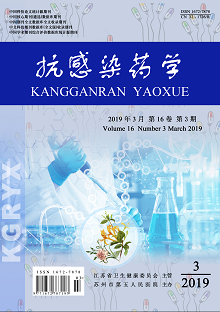ZHANG Shi-zhong, CHEN Xiao-li, TAO Guang-li
Objective: To analyze the distribution of gram-negative bacteria and their resistance to antimicrobial agents in hospitals from 2015 to 2018, and to provide a reference for clinical rational drug use. Methods: From August 2015 to August 2018, the bacterial culture data isolated from various specimens in the bacteria room of the laboratory department of the hospital were collected, and the clinical isolation of the bacteria, the distribution of the specimens, the detection rates of ESBLs and AmpC of enterobacteriaceae bacteria, and the MIC and bacterial susceptibility rates of antimicrobial agents against enterobacteriaceae bacteria as well as non-fermenting bacteria were analyzed. Results: 1 441 strains of bacteria were isolated, including 384 strains of Gram-negative bacillus and 1 058 strains of Gram-negative bacillus. Among them 219 strains of E. coli, 215 strains of Pseudomonas aeruginosa, 192 strains of Acinetobacter genera, 190 strains of Pneumonia klebsiella bacteria, 95 strains of Sewer enterobacter, 35 for deformation of bacterial strains, 32 strains of the Genus serratia, 28 strains of Eosinophilic malt oligotrophic, bacterium 22 strains for Citric acid bacillus and other 30 strains of bacteria, such as 9 strains of flu bloodthirsty bacteria, 6 strains producing gas e. coli, 4 strains of shigella, 6 strains of Pseudomonas other genera and 5 other strains of E. coli. Gram-negative bacilli were distributed in the specimens, including 589 strains in respiratory tract, 256 strains in urine, 74 strains in wound secretions, 47 strains in feces, 42 strains in blood, 44 strains in body fluids and 6 strains in other parts, accounting for 55.67%, 24.20%, 6.99%, 4.44%, 3.97%, 4.16% and 0.57%, respectively. The ESBLs and AmpC detection rates of escherichia coli were 19.63% and 0.91%, respectively, and the ESBLs and AmpC detection rates of Klebsiella pneumoniae were 23.6% and 0.00%, respectively.The detection rates of ESBLs and AmpC were 10.53% and 17.87%, respectively.The enzyme detection rates of ESBLs and AmpC were 46.88% and 0.00% respectively. Gatifloxacin, paracilin-tazobactam and cefoperazone-sulbactam showed broad antibacterial spectra and a good antibacterial activity against non-fermentative negative bacilli. Conclusion: Gram-negative bacilli are widely distributed in clinic, so we should monitor them and do some drug sensitivity tests to ensure the effectiveness of clinical treatment.
